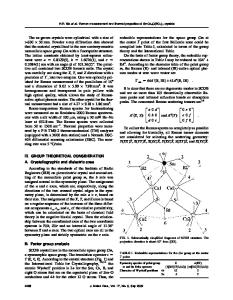Specific heat of YFe 3 (BO 3 ) 4 , Y 0.5 Gd 0.5 Fe 3 (BO 3 ) 4 , and GdFe 3 (BO 3 ) 4
- PDF / 195,567 Bytes
- 4 Pages / 612 x 792 pts (letter) Page_size
- 45 Downloads / 392 Views
RDER, DISORDER, AND PHASE TRANSITIONS IN CONDENSED SYSTEMS
Specific Heat of YFe3(BO3)4 , Y0.5Gd0.5Fe3(BO3)4 , and GdFe3(BO3)4¶ A. N. Vasilieva, E. A. Popovaa, L. N. Bezmaternykhb, V. L. Temerovb, and Z. Hiroic a Low-Temperature b Kirensky
Physics Department, Moscow State University, Moscow, 119992 Russia Institute of Physics, Siberian Division, Russian Academy of Sciences, Krasnoyarsk, 660036 Russia c Institute for Solid-State Physics, University of Tokyo, Kashiwa, Chiba, 277-8581, Japan e-mail: [email protected] Received July 14, 2005
Abstract—The specific heat was measured in the range 0.4–300 K in YFe3(BO3)4 , Y0.5Gd0.5Fe3(BO3)4 , and GdFe3(BO3)4 single crystals. Sharp anomalies were found at temperatures of first-order structural, second-order antiferromagnetic, and first-order spin-reorientational transitions. A Néel temperature of about 37 K was found to be virtually independent of presence of rare-earth ions, indicating rather weak coupling of Gd and Fe subsystems. The contribution of the magnetic system to specific heat was separated through the scaling procedure allowing determination of the magnetic entropy of Fe and Gd subsystems. At the lowest temperatures, the specific heat in GdFe3(BO3)4 exhibits a Schottky-type anomaly, which is due to Gd3+ eightfold degenerate groundlevel splitting by the internal magnetic field of the Fe subsystem of about 7 T. PACS numbers: 75.40.Cx DOI: 10.1134/S1063776106020075
The borates with the general formula RM3(BO3)4 , where R stands for a rare earth or yttrium and M = Al, Ga, Sc, Cr, Fe, have attracted a considerable attention recently because of their good luminescent and nonlinear optical properties combined with excellent physical parameters and chemical stability. The crystals of YAl3(BO3)4 and GdAl3(BO3)4 doped with Nd are used for self-frequency doubling and self-frequency summing lasers [1]. The crystals of NdAl3(BO3)4 are efficient media for minilasers [2]. In the case of borates with magnetic M = Cr, Fe ions, the applications for Faraday devices are discussed. The crystals of GdFe3(BO3)4 have multiferroic features, which presume the coexistence of elastic, magnetic, and ferroelectric order parameters [3]. Most clearly, the coupling of these parameters was observed in the vicinity of spinreorientational transition at low temperatures [4, 5]. The crystal structure of RFe3(BO3)4 belongs to the trigonal system of the CaMg3(CO3)4 type, the cell unit contains three formula units [6]. In rare-earth ferroborates, three kinds of coordinations with oxygen are present: RO6 trigonal prisms, FeO6 octahedra, and two types of triangular BO3 groups. The FeO6 octahedra share edges such that they form helicoidal chains that run parallel to the c axis and are mutually independent. The RO6 are isolated polyhedra, and each of them con¶
The text was submitted by the authors in English.
nects three helicoidal FeO6 chains. Both BO3 triangles and RO6 trigonal prisms connect three FeO6 chains. The structural and magnetic properties of rare-earth ferroborates have become the subje
Data Loading...











